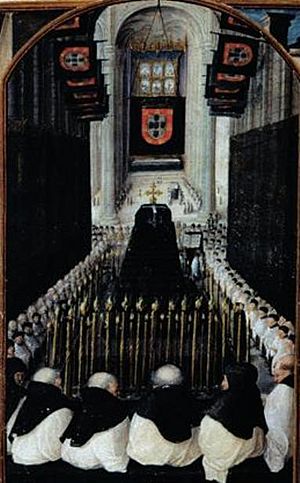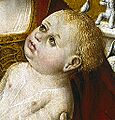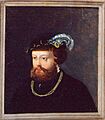Manuel I of Portugal facts for kids
Quick facts for kids Manuel I |
|
|---|---|
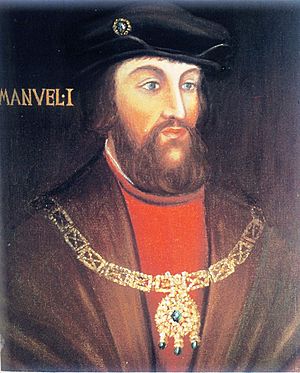
Anonymous 16th century painting of Manuel
|
|
| King of Portugal | |
| Reign | 25 October 1495 – 13 December 1521 |
| Coronation | 27 October 1495 |
| Predecessor | John II |
| Successor | John III |
| Born | 31 May 1469 Alcochete, Portugal |
| Died | 13 December 1521 (aged 52) Lisbon, Portugal |
| Burial | Jerónimos Monastery |
| Spouses |
|
| Issue see details... |
|
| House | Aviz |
| Father | Ferdinand, Duke of Viseu |
| Mother | Beatrice of Portugal |
| Religion | Roman Catholicism |
| Signature | |
Manuel I (born May 31, 1469, died December 13, 1521), also known as the Fortunate, was the King of Portugal from 1495 to 1521. He belonged to the House of Aviz, a royal family. Before becoming king, Manuel was the Duke of Beja and Viseu. He took over the throne from his cousin, John II of Portugal.
Manuel's time as king was a period of huge growth for the Portuguese Empire. Many Portuguese discoveries happened during his reign. He supported Vasco da Gama, who found a sea route to India in 1498. This led to the creation of the Portuguese India Armadas, which helped Portugal control the valuable spice trade. Manuel also started the colonization of the Americas and Portuguese India. He built a large trade empire across Africa and Asia. He was the first king to use the long title: By the Grace of God, King of Portugal and the Algarves, this side and beyond the Sea in Africa, Lord of Guinea and the Conquest, Navigation and Commerce in Ethiopia, Arabia, Persia and India.
Manuel set up the Casa da Índia, a royal office that managed Portugal's trade and empire. He funded many famous Portuguese explorers, like Pedro Álvares Cabral (who discovered Brazil) and Afonso de Albuquerque (who made Portugal very powerful in the Indian Ocean). The money from Portugal's trade and colonies made Manuel the richest king in Europe. This allowed him to support the Portuguese Renaissance, a time of great art and learning. Manuel helped many Portuguese thinkers, including the writer Gil Vicente. The unique Manueline style of architecture, which is Portugal's national style, is named after him.
Contents
Early Life and Becoming King
Manuel was born in Alcochete on May 31, 1469. He was the ninth child of Ferdinand, Duke of Viseu and Beatriz of Portugal. His father, Ferdinand, was the son of King Edward I. His mother, Beatriz, was the granddaughter of King John I of Portugal. Manuel's sister, Eleanor of Viseu, was married to King John II of Portugal.
Manuel grew up during a time when some noble families in Portugal were plotting against King John II. In 1483, Fernando II, Duke of Braganza, a powerful noble, was punished for disloyalty. Later, in 1484, Manuel's older brother, Diogo, Duke of Viseu, died in a conflict with the king after being accused of leading a plot against the crown.
Manuel had reason to be worried when King John II called for him in 1493. But his fears were unnecessary. John II wanted to name Manuel as his heir. This happened because John's son, Prince Afonso, had died, and John's attempts to make his own son, Jorge de Lencastre, Duke of Coimbra, the legal heir had failed. Because of this unexpected good fortune, Manuel was called the Fortunate. He became king when John died in 1495.
Manuel's Reign
Expanding the Empire

Manuel proved to be a strong leader, just like his cousin John II. He greatly supported Portuguese exploration of the Atlantic Ocean and helped Portuguese trade grow. During his rule, many important things happened:
- 1498: Vasco da Gama discovered a sea route to India.
- 1500: Pedro Álvares Cabral discovered Brazil.
- 1501: Gaspar and Miguel Corte-Real discovered Labrador.
- 1503: The first trading post (feitoria) was built in Brazil by Fernão de Loronha. A fort was also built in the Kingdom of Cochin in India by Afonso de Albuquerque.
- 1505: Francisco de Almeida built forts in Kilwa, Sofala, Angediva, and Cannanore as the first viceroy of India.
- 1506: Diogo de Azambuja captured Essaouira in Morocco.
- 1507: Tristão da Cunha captured Socotra, and Afonso de Albuquerque captured Oman.
- 1508: Diogo de Azambuja captured Safi in Morocco.
- 1510: Afonso de Albuquerque captured Goa in India.
- 1511: Afonso de Albuquerque captured Malacca in Malaysia.
- 1513: Dom Jaime Duke of Braganza captured Azamor in Morocco.
- 1515: Afonso de Albuquerque captured Ormus in the Persian Gulf.
The capture of Malacca in modern-day Malaysia in 1511 was part of Manuel I's plan. He wanted to control the Indian Ocean trade by taking over key trading cities like Aden, Ormuz, and Malacca.
All these events made Portugal very rich from foreign trade and helped establish a huge overseas empire. Manuel used this wealth to build many royal buildings in the "Manueline" style and to bring scientists and artists to his royal court.
Portugal also made trade agreements and alliances with the Ming dynasty in China and the Persian Safavid dynasty. During Manuel's reign, Pope Leo X received a grand group of visitors from Portugal. This visit was meant to show all of Europe how rich Portugal had become.
Changes to Laws and Government
During Manuel's reign, the king had almost complete power. The Portuguese Cortes (the kingdom's assembly) met only three times while he was king, always in Lisbon, where the king lived.
He improved the justice system and updated the rules for towns and cities. He also modernized taxes and other payments owed to the crown. During his time, the laws of Portugal were rewritten and published as the Manueline Ordinances.
Religious Policies

Manuel was a very religious man. He spent a lot of Portugal's money sending missionaries, like Francisco Álvares, to the new colonies. He also paid for the building of religious places, such as the Monastery of Jerónimos. Manuel also wanted to start another crusade against the Turks.
His relationship with the Portuguese Jews started well. At the beginning of his reign, he freed all Jews who had been captured during John II's rule. However, things changed because Manuel wanted to marry Infanta Isabella of Aragon. She was the heir to the future united kingdom of Spain and the widow of his nephew, Prince Afonso. Isabella's parents, Ferdinand and Isabella, had forced Jews to leave Spain in 1492. They would not let their daughter marry the king of a country that still allowed Jews to live there. So, in the marriage agreement, Manuel I agreed to force the Jews of Portugal to convert or leave.
In December 1496, a law was passed stating that all Jews must either become Christian or leave the country without their children. However, those who chose to leave could only do so on ships chosen by the king. When these people arrived at the port in Lisbon, they were met by religious leaders and soldiers. They tried to force or persuade the Jews to be baptized and prevent them from leaving.
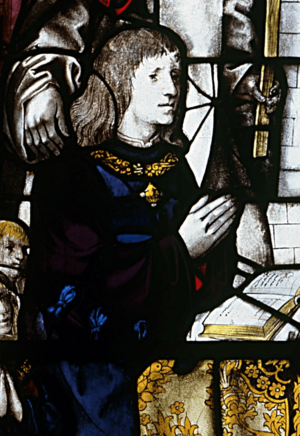
This period effectively ended the official presence of Jews in Portugal. After this, all converted Jews and their families were called "New Christians." They were given a grace period of thirty years during which their faith would not be questioned. This period was later extended until 1534.
During the Lisbon massacre of 1506, thousands of people accused of being Jews were killed. Manuel had the leaders of this riot executed.
Manuel also ordered Muslims to leave Portugal. He is known to have pressured Ferdinand and Isabella of Spain to stop allowing Islam in their kingdom as well.
Family Life
Isabella died while giving birth in 1498. This ended Portugal's hopes of ruling Spain, a dream many Portuguese rulers had held. Manuel and Isabella's young son, Miguel da Paz, was named Prince of Asturias, Prince of Portugal, and Prince of Girona. This made him the heir to the thrones of Castile, Portugal, and Aragon. But he died in 1500 at the age of two, ending these grand plans.
Manuel's next wife, Maria of Aragon, was his first wife's younger sister. Two of their sons later became kings of Portugal. Maria died in 1517.
Manuel had many children with his wives. His son, John III of Portugal, became king after him. His daughter, Isabella, married Charles V, Holy Roman Emperor, a very powerful ruler. Another son, Henry, also became King of Portugal later in life.
Honors and Death
Manuel I received the Golden Rose from Pope Julius II in 1506 and from Pope Leo X in 1514. He was the first person to receive this special honor more than once.
In December 1521, while the Black Plague was spreading in Lisbon, Manuel and his court were kept separate in Ribeira Palace. On December 4, Manuel started to have a high fever. He became very ill by December 11 and died on December 13, 1521, at 52 years old. His son, John III of Portugal, became the new king.
The next day, Manuel's body was taken to the Belém district of Lisbon in a black velvet coffin. Many people followed, mourning his death. He was first buried at Restelo Church. Later, in 1551, his remains were moved to the Jerónimos Monastery, where the royal family of the House of Aviz was buried. His second wife, Maria of Aragon, was also moved there.
Images for kids
See also
 In Spanish: Manuel I de Portugal para niños
In Spanish: Manuel I de Portugal para niños
- Manueline, an architectural style named after Manuel
- Portugal in the Age of Discovery
- Português
- Royal Palace of Évora



